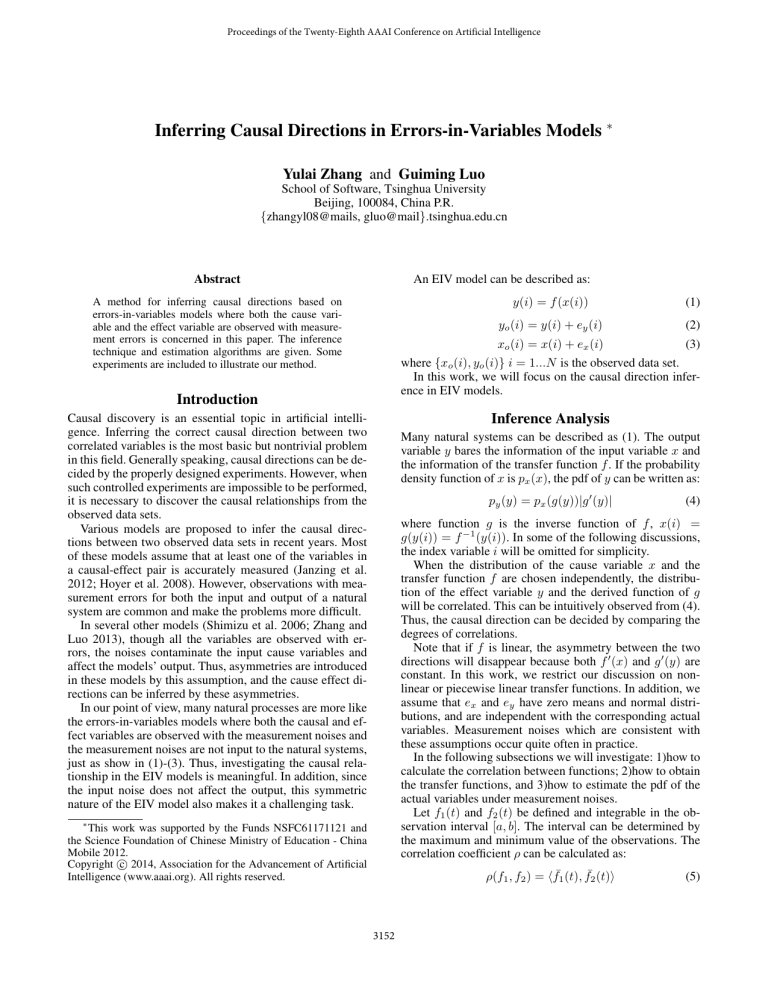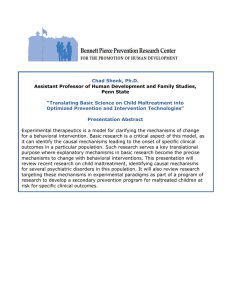
Proceedings of the Twenty-Eighth AAAI Conference on Artificial Intelligence
Inferring Causal Directions in Errors-in-Variables Models ∗
Yulai Zhang and Guiming Luo
School of Software, Tsinghua University
Beijing, 100084, China P.R.
{zhangyl08@mails, gluo@mail}.tsinghua.edu.cn
Abstract
An EIV model can be described as:
A method for inferring causal directions based on
errors-in-variables models where both the cause variable and the effect variable are observed with measurement errors is concerned in this paper. The inference
technique and estimation algorithms are given. Some
experiments are included to illustrate our method.
y(i) = f (x(i))
(1)
yo (i) = y(i) + ey (i)
(2)
xo (i) = x(i) + ex (i)
(3)
where {xo (i), yo (i)} i = 1...N is the observed data set.
In this work, we will focus on the causal direction inference in EIV models.
Introduction
Inference Analysis
Causal discovery is an essential topic in artificial intelligence. Inferring the correct causal direction between two
correlated variables is the most basic but nontrivial problem
in this field. Generally speaking, causal directions can be decided by the properly designed experiments. However, when
such controlled experiments are impossible to be performed,
it is necessary to discover the causal relationships from the
observed data sets.
Various models are proposed to infer the causal directions between two observed data sets in recent years. Most
of these models assume that at least one of the variables in
a causal-effect pair is accurately measured (Janzing et al.
2012; Hoyer et al. 2008). However, observations with measurement errors for both the input and output of a natural
system are common and make the problems more difficult.
In several other models (Shimizu et al. 2006; Zhang and
Luo 2013), though all the variables are observed with errors, the noises contaminate the input cause variables and
affect the models’ output. Thus, asymmetries are introduced
in these models by this assumption, and the cause effect directions can be inferred by these asymmetries.
In our point of view, many natural processes are more like
the errors-in-variables models where both the causal and effect variables are observed with the measurement noises and
the measurement noises are not input to the natural systems,
just as show in (1)-(3). Thus, investigating the causal relationship in the EIV models is meaningful. In addition, since
the input noise does not affect the output, this symmetric
nature of the EIV model also makes it a challenging task.
Many natural systems can be described as (1). The output
variable y bares the information of the input variable x and
the information of the transfer function f . If the probability
density function of x is px (x), the pdf of y can be written as:
py (y) = px (g(y))|g 0 (y)|
(4)
where function g is the inverse function of f , x(i) =
g(y(i)) = f −1 (y(i)). In some of the following discussions,
the index variable i will be omitted for simplicity.
When the distribution of the cause variable x and the
transfer function f are chosen independently, the distribution of the effect variable y and the derived function of g
will be correlated. This can be intuitively observed from (4).
Thus, the causal direction can be decided by comparing the
degrees of correlations.
Note that if f is linear, the asymmetry between the two
directions will disappear because both f 0 (x) and g 0 (y) are
constant. In this work, we restrict our discussion on nonlinear or piecewise linear transfer functions. In addition, we
assume that ex and ey have zero means and normal distributions, and are independent with the corresponding actual
variables. Measurement noises which are consistent with
these assumptions occur quite often in practice.
In the following subsections we will investigate: 1)how to
calculate the correlation between functions; 2)how to obtain
the transfer functions, and 3)how to estimate the pdf of the
actual variables under measurement noises.
Let f1 (t) and f2 (t) be defined and integrable in the observation interval [a, b]. The interval can be determined by
the maximum and minimum value of the observations. The
correlation coefficient ρ can be calculated as:
∗
This work was supported by the Funds NSFC61171121 and
the Science Foundation of Chinese Ministry of Education - China
Mobile 2012.
Copyright c 2014, Association for the Advancement of Artificial
Intelligence (www.aaai.org). All rights reserved.
ρ(f1 , f2 ) = hf¯1 (t), f¯2 (t)i
3152
(5)
where h·, ·i is the inner product operator and the values of
the functions are normalized in the interval [a, b] by f¯(t) =
(f (t) − mean(f (t)))/kf (t) − mean(f (t))k2 .
In order to infer the causal direction, we chose f1 (t) =
|f 0 (t)|, f2 (t) = px (t) for ρin , and f1 (t) = |g 0 (t)|, f2 (t) =
py (t) for ρout . The causal directions can be determined by
the fact that |ρin | < |ρout |.
Step 2. Solve (6), get the result of θ(t) at tth step.
Step 3. Solve (8), and get σe2x (t). While |σe2x (t)/σe2x (t −
1) − 1| > δ, go back to Step 2.
Step 4. Calculate the pdf px (x) using (7)
Step 5. Calculate ρxy by (5)
Step 6. Exchange x and y, do Step 2 to Step 5 again to
calculate ρyx .
Step 7. If |ρxy | < |ρyx |, the causal direction is x causes y,
and if |ρyx | < |ρxy |, the causal direction is y causes x.
In this experiment, we compare the method in this paper
with the entropy based IGCI method proposed in (Janzing et
al. 2012). The data is from second order polynomial models.
θd is randomly generated between [0,2]. The input data x is
generated by a uniform distributed between -0.5 and 1.5. σe2x
and σe2y are equally selected from 0.1 to 0.3. The percentage
of successful causal direction inference for both methods are
shown in the fig.1. The method proposed in this paper gives
better results for data with measurement errors.
Estimate Algorithms
Regression is a core research topic in many research fields.
The regression for EIV models encounters extra difficulties.
Since the derived functions of f and g are needed, a parametric model with explicit formulations are more suitable
for our task. We expand
Pn the function f in basis functions
ϕd , and let f (x) = d=0 θd ϕd (x). For EIV model the parameter vector θ can be obtained by:
min J1 = θT (Eϕ(xo )ϕ(xo )T )θ(θT Cθ)−1
θ
(6)
100%
where ϕ(xo ) = [yo , ϕ0 (xo ), ..., ϕd (xo )]T , and θ =
[−1, θ0 , ..., θd ]T . An explicit estimator for the polynomial
basis was proposed in (Vajk and Hetthéssy 2003). This algorithm requires a known covariance matrix C which can
be determined by σe2x and σe2y in our model. From (2)
and (3), we
R can obtain the probability density function by:
pxo (x) = px (x − ε)pε (ε)dε. The pdf of xo is the convolution of pdf of x and ex . The deconvolution can be calculated
by the pdfs’ characteristic functions:
φx (t) = φxo (t)/φex (t)
80%
60%
40%
20%
0%
σex
0.15
0.20
EIVCI
(7)
0.25
IGCI
0.30
σ2e
x
Figure 1: Experiment Result of EIVCI (EIV Causal Inference) and the IGCI method.
where the characteristic function φx (t) = Eeitx can be calculated by FFT. Since we have assumed a zero mean gaussian density, the rest problem is how to obtain the variances
of the noises ex and ey .
A noise variance estimate criterion based on instrumental variable for linear dynamic EIV models is proposed in
(Diversi, Guidorzi, and Soverini 2006). This criterion can be
extended to polynomial nonlinear models as:
min
J2 = θT (E(ϕ̃ϕ̄T )T )E(ϕ̃ϕ̄T )θ
2
0.10
References
Diversi, R.; Guidorzi, R.; and Soverini, U. 2006. Yulewalker equations in the frisch scheme solution of errorsin-variables identification problems. In Proc. 17th international symposium on mathematical theory of networks and
systems. MTNS. Kyoto, Japan. July, 391–395.
Hoyer, P. O.; Janzing, D.; Mooij, J.; Peters, J.; and
Scholkopf, B. 2008. Nonlinear causal discovery with additive noise models. In Proceedings of The Twenty-Second
Annual Conference on Neural Information Processing Systems (NIPS 2008).
Janzing, D.; Mooij, J.; Zhang, K.; Lemeire, J.; Zscheischler, J.; Daniušis, P.; Steudel, B.; and Schölkopf, B. 2012.
Information-geometric approach to inferring causal directions. Artificial Intelligence 182:1–31.
Shimizu, S.; Hoyer, P. O.; Hyvarinen, A.; and Kerminen, A.
2006. A linear non-gaussian acyclic model for causal discovery. Journal of machine learning reseach 7:2003–2030.
Vajk, I., and Hetthéssy, J. 2003. Identification of nonlinear
errors-in-variables models. Automatica 39(12):2099–2107.
Zhang, Y., and Luo, G. 2013. An entropy based method for
causal discovery in linear acyclic model. In Neural Information Processing, LNCS, 250–256. Springer.
(8)
T
s.t.σe2y = Ryy − Ryx (Rxx − Eϕ(ex )ϕ(ex )T )−1 Ryx
where Ryx = Eyo [ϕ1 (xo ), ..., ϕd (xo )], Ryy = Eyo yoT and
Rxx = E[ϕ1 (xo ), ..., ϕd (xo )]T [ϕ1 (xo ), ..., ϕd (xo )] can be
calculated directly. ϕ̄ = [y, ϕ0 (x), ..., ϕd (x)]T , and ϕ̃ =
[ϕd+1 (x), ..., ϕd+q (x)]T is the instrumental variable. Note
that although the accurate values of x, y and ex are not available, E(ϕ(ex )ϕ(ex )T ) and E ϕ̃ϕ̄T can be presented by the
observation xo , yo and σe2x , σe2y , so σe2x is the only independent variable in (8).
Algorithm and Experiments
We propose an EM style algorithm in this work to solve (6)
and (8) together as follow:
Step 1. Select the model order n and the length of the
instrumental variable q. Initialize the values of the optimization variables in (6) and (8).
3153





